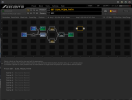so, after some pondering - I still don't think you need dual input which is going to be awkward + it may be tricky to get the exact same signal coming into the grid on both due to special input sauce on input1 only. As in the example below, if you go out L/R through loop3 (I use loop3 because it is unity gain so best for pre pedals) into your mono OD pedals with your clean amp OD pedals in loop3L and your dirt amp OD pedals in loop3R (same separation / order as you would set them up with split input), then back in to hard panned amp blocks 1 and 2 set up for Input L and R respectively, and then into a stereo hard panned cab block, then output1 to your DAW will yield your Clean L with active clean OD pedals, and your Dirt R with active dirt OD pedals. L/R could be separated / mixed in DAW (or in the preset, ie if you wanted the two going out separately (add Vol blocks to send L to out1 and R to out2)).
methinks... maybe?
View attachment 115420


